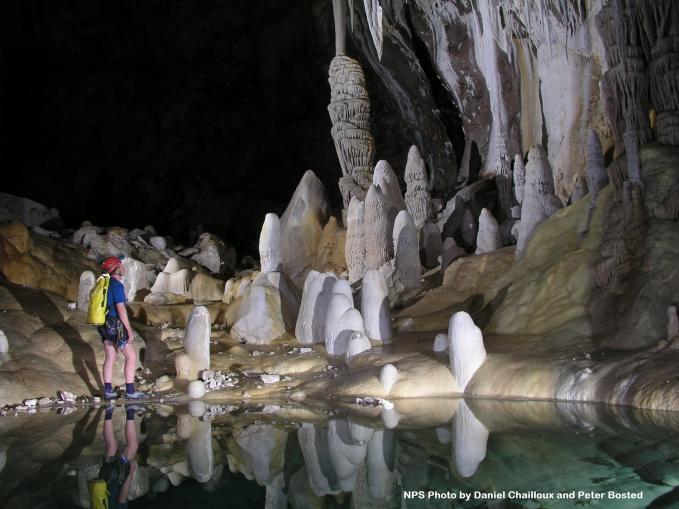Travel to Carlsbad Caverns National Park in southern New Mexico and you'll arrive at a landscape with more than 100 caves, have the opportunity to witness thousands of bats take flight into the Chihuahuan Desert, marvel at the beauty of ancient sea ledges and acid-dissolved limestone, and walk down what's been called “the road to hell.”
When approaching the main cave, visitors are met by a steep and winding trail that descends into the main cavern. As you walk down the trail, the cavern seems to swallow the daylight, hence the nickname “road to hell.” For those who prefer to walk the “righteous path,” the park’s surface landscape is also home to flowering cactus and desert wildlife within the beautiful, canyon-cut desert of Carlsbad, New Mexico.
Traveler's Choice For: Being amazed at all the "space" underground, bats, geology.
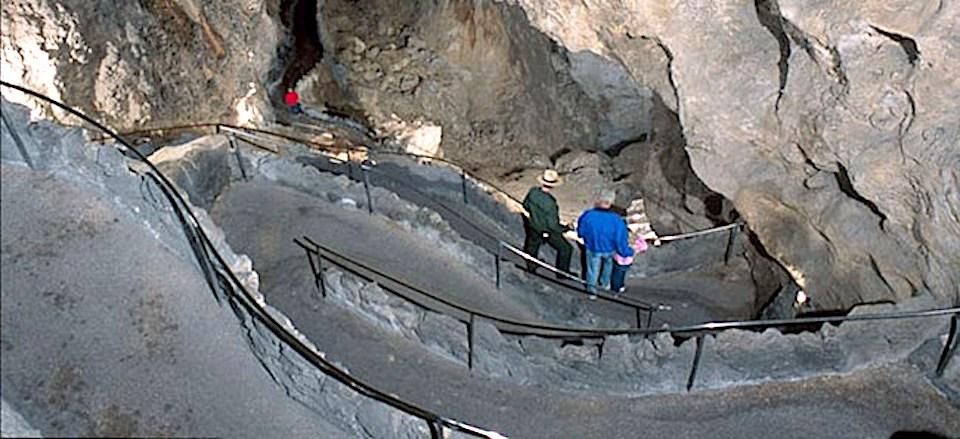
Natural Entrance trail down into Devils Den/NPS, Peter Jones
Getting Around Carlsbad Caverns National Park
Carlsbad Caverns National Park is located near Carlsbad, New Mexico, and can be reached via U.S. Highway 62/180. It is about 18 miles southwest of Carlsbad, New Mexico. The driving distance is 149 miles east of El Paso, Texas. There is only one entrance road to the park, the Carlsbad Caverns Highway.
Carlsbad is served by Greyhound and TNM&O bus lines. Major airlines serve Roswell and Albuquerque, New Mexico, and El Paso, Lubbock and Midland, Texas. Rental cars and taxi service are available from the airport in Carlsbad.
Park History
Carlsbad Caverns holds a history that dates back to the prehistoric era, and is one of 300 limestone caves in the southeastern corner of New Mexico, not far from the Texas border. Now, while this doesn’t necessarily mean dinosaurs walked the caverns, the permian reef certainly was home to interesting creatures. These caves were created within a fossil reef laid down by an inland sea that existed about 250 to 280 million years ago.
The caverns contain unique examples of marine fossils that date back to the Permian period; these fossils are found within the limestone formation. Among the fossils found here are sponges, moss animals, rare horn coral, nautiloids, and snails.
In the 1400s, native cultures began exploring what is now Carlsbad’s sister park, Guadalupe Mountains National Park. A century later, Spanish explorers often ventured into parts of Carlsbad Caverns, as well.
Spain claimed the Southwest until 1821, when Mexico revolted and claimed independence, according to National Park Service. At the same time, Mexico was fighting the United States’ westward expansion, but lost, giving way to the New Mexico Territory in 1850.
This created cultural conflict between the native peoples who had resided in the area for so long and the United States government. What is now Carlsbad was established in 1888, 24 years before New Mexico officially became a state.
Ray V. Davis photographed parts of the caverns in about 1915, sparking public interest in them after the New York Times published some of his work in 1923. This led to the caverns being surveyed and mapped months later, and on October 25, 1923, President Calvin Coolidge signed the legislation that established Carlsbad Cave National Monument
The caves were explored extensively by Dr. Willis T. Lee and Jim White in 1924, and by 1925 a staircase was installed from the natural entrance to the Bat Cave, eliminating the use of a guano bucket to enter the caverns and marking the beginning the road to hell.
As progress was continuously made to explore the caverns, dirt paths were created for the Main Corridor, Kings Palace, Queens Chamber, and parts of the Big Room. In addition, by 1926 an electric lighting system was implemented for the Main Corridor and Kings Palace.
As renovations continued over the years, Congress redesignated the caverns at Carlsbad Caverns National Park in May 1930. By January of 1932, the park’s 750-foot elevator was operating after about a year of construction. Two more elevators were added in the mid-1950s.
In December 1955, the caverns were declared a World Heritage Site by the United Nations Educational, Scientific and Cultural Organization.
A Look Into The Caves
While the national park counts 119 different caves, only three are open to the public for tours: the famous Carlsbad Cavern, Slaughter Canyon Cave, and Spider Cave. However, the Slaughter Canyon and Spider Cave are only available to explore with a guide. While Lechuguilla Cave is world-renowned, it is open only to researchers.
Unlike most caves, Carlsbad Caverns did not form simply via rainwater slowly dissolving limestone and eventually carving out cave systems. These caverns came to be about four to six million years ago when hydrogen-sulfide-rich waters began to migrate through fractures and faults in the Capitan limestone, according to National Park Service. As this unique water mixed with rainwater and oxygen, it formed sulfuric acid that dissolved the limestone and formed the caverns (leaving behind huge gypsum deposits, clay and silt).
Over time, deeper cave passages formed as the active level dropped, growing great cave formations to look much like they do today.
Some of the most popular caves are the Carlsbad Cavern and Lechuguilla Cave, which is more than 140 miles long. Lechugilla Cave is not open to the public due to its delicate formations; only permitted scientific expeditions are allowed. People continue to explore the caverns, pushing new routes and discovering their unique characteristics, such as speleothems, fungi, and the depths of the caves.
For quite some time, Lechuguilla Cave held no significance to the park. In the 1950s cavers heard gusting wind on the floor of the cave, but it wasn't until three decades later, in 1984, that cavers from Colorado gained Park Service permission to dig around to see if they could find a passageway. "The breakthrough, into large walking passages, occurred on May 26, 1986," the park notes on its website.
Through this process this national park is now home to one of the longest caves in the world, and the second deepest limestone cave in the United States.
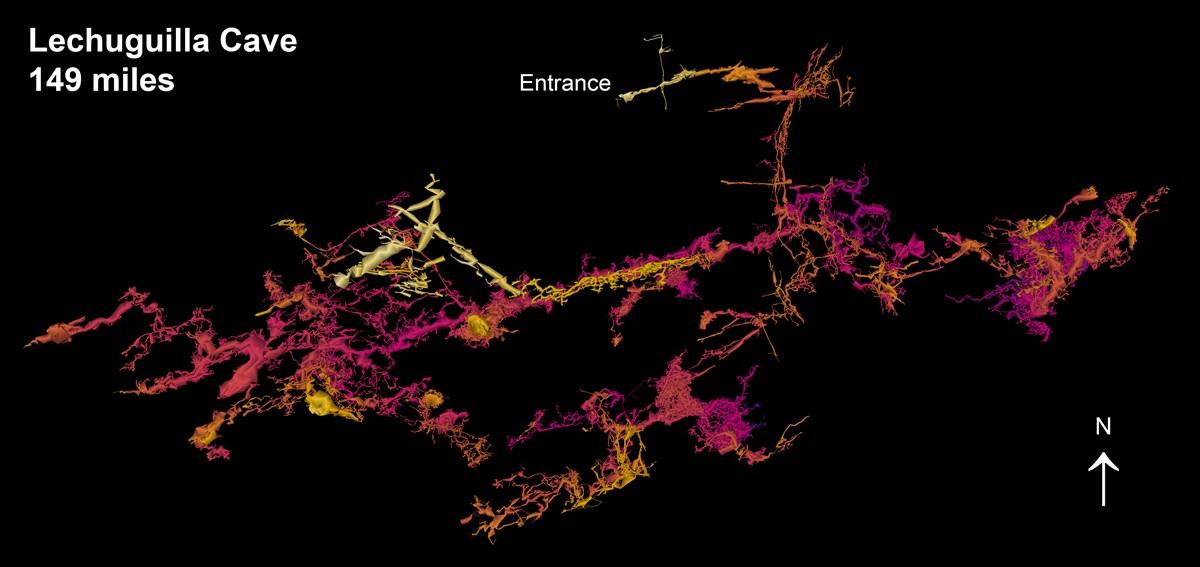
Map of the more than 145 miles of passageways in Lechuguilla Cave as of July 2019/NPS
Other than its record size, Lechuguilla Cave revealed a variety of rare speleothems, which are structures formed from depositions in caves; some of these speleothems had never been seen anywhere.
Other findings included an abundance of gypsum in shapes of chandeliers, hairs and beards, soda straws, hydromagnesite balloons, cave pearls, subaqueous helictites and rusticles, u-loops, j-loop and lemon yellow sulfur deposits. This large amount of findings became very exciting for scientific exploration.
While the Lechuguilla Cave is incredibly rich in speleothems compared to any other cave in the area, it does not contain a room larger than Carlsbad’s Big Room.
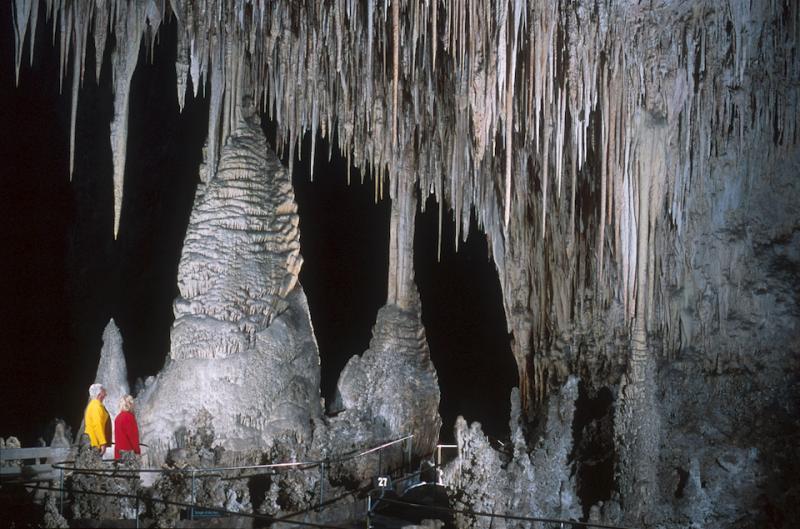
Temple of the Sun in the Big Room/NPS, Peter Jones
Other speleothems commonly found in the caverns include stalactites, draperies, ribbons or curtains found on ceilings, while on the cave floor are totem poles, flowstone, rimstone dams, lily pads, shelves, cave pools and stalagmites, according to National Park Service.
Scientists believe that caverns may travel deep enough to study five different geologic formations, contain rare bacteria such as chemolithoautotrophic (rock eating), and might hold medicinal qualities that would benefit humans.
Threatening this incredible cave system are nearby lands managed by the U.S. Bureau of Land Management where energy exploration could cause oils and gases to leak into the cave system and destroy the delicate ecosystem and threaten people’s safety. However, the park closely oversees this in order to minimize this threat.
Visitors can explore the caverns through ranger-guided tours of Carlsbad Cavern, Slaughter Canyon Cave, and Spider Cave, while visitors with technical caving skills can participate in self-guided and ranger-guided tours to many caves with proper permits.
Wildlife At The Caverns
Along with being part of the Chihuahuan Desert, the caverns reveal their overlapping influences of ecosystems through portions of the Sierra Madre, Rocky Mountains, and Great Plains. These ecosystems are identifiable as you go higher in elevation in the area.
This area is looked at to be a predominantly shrub desert, lacking in the expected cacti one would expect from the diverse area. However, Carlsbad Caverns has a variety of wildlife throughout the area, the best known being the bats.
While many people may connect bats to horror films, vampires, and Halloween, the Park Service recognizes these creatures for all their beauty and highlight their unique nature throughout the year.
Home to 17 species of bats, Carlsbad Caverns contains a "bat flight amphitheater" where visitors can observe these creatures taking off from out of the cave during late May to October evenings. Rangers deliver a program prior to hundreds, if not thousands, of bats taking off into the sunset to search out insect meals.
According to National Park Service, the best bat flights to find often happen during August and September, as baby bats and migrating bats join those flights.
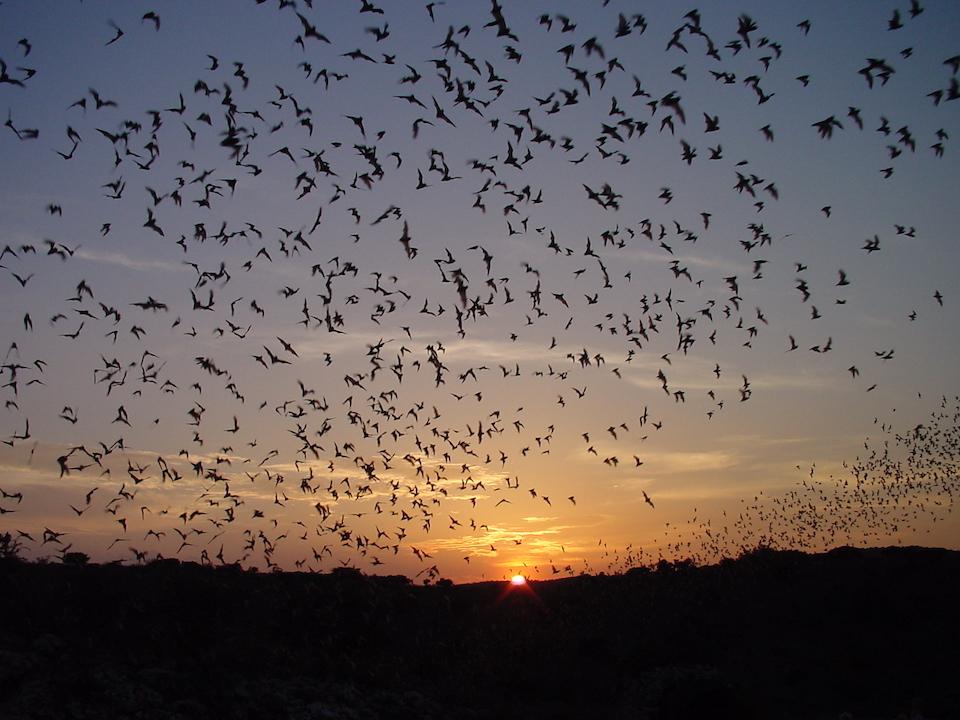
A popular park event during the summer months are the "bat flights" out of the cave/NPS
The park is also home to 67 other mammal species, though these animals are rarely seen. Some examples are black bears, spotted skink, and non-native animals, such as eastern fox squirrels.
Some native animals hidden within the national park are mule deer, cougars, and javelinas. While they are within the park they are not as frequently seen, especially when compared to Brazilian free-tailed bats.
Ultimately the diversity of this area's ecosystem, which includes water from Rattlesnake Springs, a rare desert wooded riparian, is home to 357 species of birds, 55 different reptiles and amphibians, five species of fish, and a growing list of more than 600 different insects.
The wildlife that can be found at Carlsbad Caverns makes this national park an all-round experience whether you are above ground, or in the deep pathways of the caverns.
Traveler's Checklist
1. Visitor Center: Within the center you can experience hands-on exhibits that give a greater understanding of cave formation, park history and the wildlife within the area. In addition, you can browse the gift shop and enjoy the restaurant.
2. Explore the Caverns at your own pace: the Big Room and Natural Entrance trails are available for visitors to explore on their own. The Big Room Trail is the most popular of the park and is the largest single cave chamber by volume in North America. The Natural Entrance trail is a steep trail equivalent to walking down a 75-story building. Along the way you can see the Devil’s Spring, Whale’s Mouth, and Iceberg Rock cave formations.
3. Ranger-Guided Tours: Get a unique guided experience through the Slaughter Canyon Cave Tour, Hall of the White Giant, and lower and left hand tunnel tours. These experiences are so unique that special equipment and protection is used to avoid a fungus known as “White-nose Syndrome,” which is harmful to bats. For more information, click here.
4. Surface hiking trails: Come out from the dark caverns and get some sunlight with 11 surface hiking trails available. Ask a park ranger at the visitors center for more information on hiking, including the Guadalupe Ridge Trail.
5. Bat Flight Program: Take a seat at the Bat Flight Amphitheater and look into the sky in awe as bats fly out of the cavern into the sunset in search of their next meal.
6. Night Sky Programs: After experiencing the bats of Carlsbad take flight, enjoy star walks, moon hikes, meteor shower viewings, telescope programs, or spot the International Space Station. *These are not everyday events, so be sure to check the park’s calendar!*
7. Dawn of the Bats: Every third Saturday of July join the park at dawn to welcome home hundreds of thousands of bats that call the caverns home April through October.
First-Time Visitor Tips
1. While the weather outside may be hitting 100 degrees, always bring a light jacket with you into the caverns, where it is chilly year-round with an average temperature of 56 degrees Fahrenheit.
2. For safety purposes, wear closed-toed shoes with good traction to avoid slipping on wet or damp portions of the Big Room and Natural Entrance trails.
3. Do not bring food or snacks of any kind into the caverns to avoid damaging the cavern formations and bringing harm to wildlife. You are allowed to carry water.
4. Keep your voice down, as noises travel up to a quarter-mile inside the cavern.
5. Remember your camera, flash photography is permitted within the caverns.
Weather
The Chihuahuan Desert is commonly known for its hot and dry climate; for Carlsbad Caverns, this stands to be true. Visitors can expect hot summers with daily high temperatures ranging between 90-100 Fahrenheit.
While there is the occasional snow and icy temperatures in the winter, on average the park sees 278 sunny days a year, according to park staff.
Camping
While the park offers no overnight lodging or campgrounds itself, the option to camp in the park's rugged backcountry is permitted with the proper permit. These permits can be found at the visitor center for free when you arrive; however, you cannot reserve them.
The park does not permit overnight RV parking.
Available to visitors interested in an overnight stay are the nearby campground and amenities about seven miles out in White’s City, New Mexico. Or, consider exploring another national treasure and drive 40 minutes to Guadalupe Mountains National Park, where camping is permitted.

